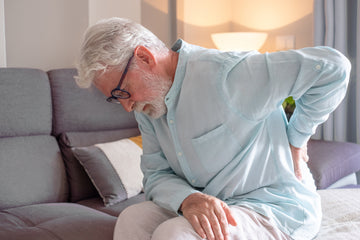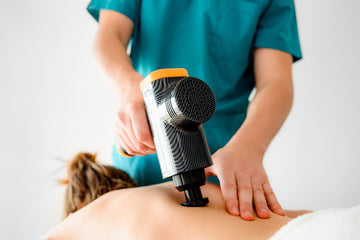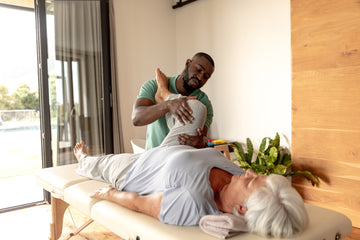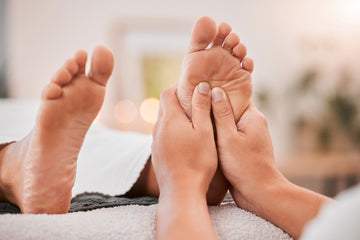Aging is a part of life that we can’t avoid, and as we get older, our bodies go through many changes. One of the most common (and normal) complaints about aging is experiencing aches and pains. These aches and pains result from the wear and tear our bodies accumulate over the years. Even though this is a natural part of life, it can be uncomfortable and affect our quality of life. In this article, we explore the answer to “what are normal aches and pains of aging”, what contributes to them, how to differentiate between normal discomfort and potential health concerns, and different ways of finding relief.
What are Considered Normal Aches and Pains of Aging?
As we get older, our bodies undergo many physiological changes. The way these changes affect the body varies from person to person, but the common denominator seems to be aches and pains. Some of the discomforts associated with the aches and pains of aging include:
- Joint pain: Joint pain is perhaps one of the most common complaints among older adults. Conditions like osteoarthritis, which cause the cartilage in the joints to deteriorate, can lead to stiffness, swelling, and pain in areas such as the knees, hips, and hands.
- Muscle stiffness: Muscle stiffness is another common issue that can result from aging. This stiffness can make it challenging to perform everyday activities and may occur due to reduced muscle mass and flexibility.
- Back pain: Back pain, especially in the lower back, is a frequent complaint of aging individuals. This can be attributed to age-related changes in the spine, such as degenerative disc disease and spinal stenosis.
- Headaches: Aging can also bring about an increased likelihood of experiencing headaches or migraines. These can be due to various factors, including changes in blood vessels and hormone levels.
- Arthritis: Arthritis pain and flare ups, which encompasses various inflammatory joint conditions, can lead to persistent pain and discomfort in the joints. Rheumatoid arthritis, for instance, is an autoimmune disease that affects the joints and can lead to chronic pain and inflammation.
- Neuropathy: Neuropathy, or nerve damage, can result in tingling, numbness, and burning sensations in the extremities. This condition is often associated with diabetes and other age-related health issues.
Causes of Normal Aches and Pains of Aging
To better manage and mitigate discomfort from the normal aches and pains of aging, you must first understand what causes it. These factors may include, but are not limited to, wear and tear, which accumulates over time and results in cartilage breakdown, muscle mass loss, and musculoskeletal changes. Inflammation also plays a significant role in age-related conditions like arthritis, which amplifies pain and discomfort in the joints and other areas.
Aging adults may also be faced with reduced bone density, which can increase vulnerability to fractures and injuries, especially if they have conditions like osteoporosis. Hormone changes, more commonly in premenopausal women, can contribute to bone density loss and muscle weakness – intensifying pain and discomfort.
Differentiating Between Normal Aches and Pains & Potential Health Concerns
Some of the aches and pains of aging are normal – as our bodies change with the growing years, we begin feeling the wear and tear of all our adventures. But how do we tell the difference between ‘normal’ and potentially concerning?
It’s important to remember what normal aches and pains of aging are and what could be a potentially serious health concern. Four key factors of determining what are normal aches and pains of aging and what could be something more serious are:
- Duration and persistence: Normal aches and pains typically occur or are intermittent. If you experience persistent pain that does not improve with rest or over-the-counter pain relief, it may be a cause for concern, like an overuse injury.
- Sudden or severe pain: Abrupt and severe pain without apparent cause should be taken seriously. It may indicate a more serious issue, such as a fracture or cardiovascular problem.
- Impact on daily life: If your pain significantly hinders your ability to perform daily activities or affects your mobility, you should seek medical attention.
- Associated symptoms: Pay attention to other symptoms accompanying your discomfort, such as fever, weakness, numbness, or difficulty breathing. These could indicate a more significant health issue that requires immediate attention.
Methods to Help with Normal Aches and Pains of Aging
The aches and pains of aging are often unavoidable as we get older. The pain and discomfort that may accompany it varies in severity, but it doesn’t mean that relief isn’t possible. There are several ways to get some relief from this discomfort, including:
- Exercise: Regular, low-impact exercises such as walking, swimming, or tai chi can help improve joint mobility, strengthen muscles, and reduce stiffness.
- Stretching: Incorporate daily stretching routines to maintain flexibility to help stiff joints loosen up and experience relief. Yoga can be particularly beneficial for increasing flexibility and reducing pain.
- Diet: A balanced diet rich in anti-inflammatory foods, such as fruits, vegetables, whole grains, and omega-3 fatty acids, can help reduce inflammation and support overall joint health.
- Medications: Over-the-counter pain relievers, such as acetaminophen or nonsteroidal anti-inflammatory drugs (NSAIDs), can temporarily relieve discomfort.
- Physical therapy: Physical therapy sessions with a trained therapist can help address specific pain-related issues and provide personalized exercises and strategies for pain management.
- Massage and heat therapy: Regular massages or heat can relax muscles and reduce pain and tension. Massage chairs can also provide relief for some individuals, combining the benefits of massage and heat therapy.
- Assistive devices: Utilize devices such as braces, canes, or walkers to reduce the strain on joints and muscles while performing daily activities.
- Stay hydrated: Proper hydration is essential for maintaining healthy joints and muscles. Drink adequate water throughout the day to prevent dehydration, which can intensify pain.
- Adequate sleep: Ensure you get enough restorative sleep each night. It is crucial for the body's natural healing processes.
- Stress reduction: High levels of stress can intensify pain. Practice relaxation techniques such as meditation or deep breathing to manage stress and improve overall well-being.
Managing Normal Aches and Pains of Aging at Home
The aches and pains of aging don’t have to control your life. By understanding contributing factors and methods to manage discomfort and alleviate pain, you can enhance your quality of life as you grow older – tackling normal aches and pains of aging. By exercising more, maintaining proper nutrition, or incorporating a luxury massage chair into your home, you can reduce the pain and discomfort associated with aging.
Disclaimer: This content is not medical advice. Please consult with your health care professional when considering implementing changes to your health or workout routines to ensure it’s compatible with your needs.





